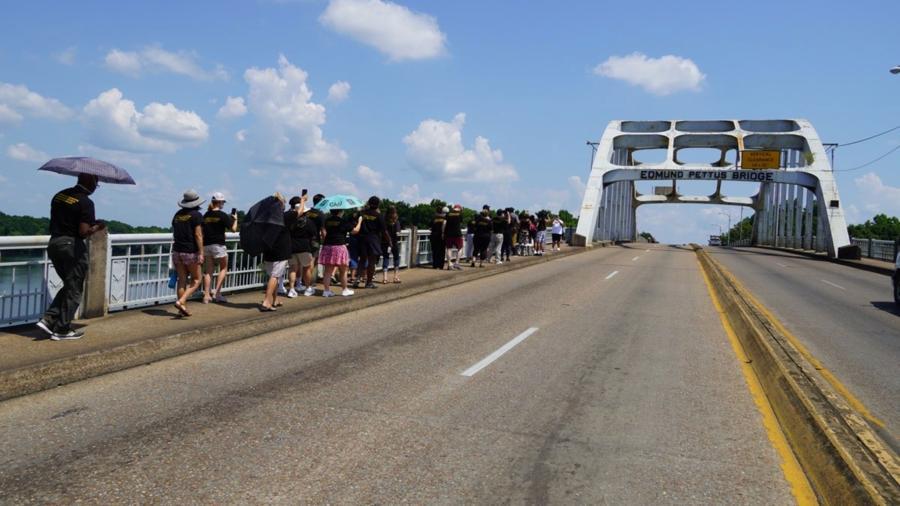Westmont Magazine Tracing the March of the Civil Rights Movement

Sonia Geary Luginbuhl ’01 And Hannah Belk ’17 live near each other in Los Angeles County, but they first met in 2022 on a civil rights tour to four Southern states. Sonia’s entire family — her husband, Kurt, and their three children, ages 13, 11 and 7 — signed up to learn more about the ongoing pursuit of racial justice.
Hannah, who first took the tour in 2018, helped coordinate it as a staff member at the Fellowship Center for Racial Reconciliation at Fellowship Church in Monrovia, California, which organizes these trips. More than 40 people of various ages and races participated in the nine-day event that began in New Orleans, moved on to Mississippi and Memphis and concluded in Alabama.
Sonia recalls the Sunday they started in New Orleans and traveled to Jackson, Mississippi, to visit the John Perkins Foundation. “I read Perkins’ books in seminary, and after meeting this 94-year-old man and hearing him preach, I recognized him as a prophetic voice and an elder we need to listen to,” she says. They next toured the Masonic Temple in Jackson, where people in the civil rights movement gathered. Some of these living legends met with the group and told their stories. “Hearing from those who lived through terrorizing experiences was unbelievable,” Sonia says. “It was the embodiment of learning. The kids kept journals and noted that some of these speakers had been teenagers when they first got involved.”
Hannah enjoyed interacting with participants. “It was great to have Sonia and her whole family and see how the kids experienced everything,” she says. “They enriched the trip tenfold. People ranged in age from 76 to 7, and seeing the wisdom of the group was so profound for me — generations see things differently.”
“Hannah worked hard on the trip for every participant in our group, and I worked hard as a parent,” Sonia says. “Kurt and I were parents first and learners second. He has had fewer opportunities to engage these issues with people face-to-face, and he seemed to get the most out of the trip. Learning alongside children gives you an incredible perspective. It was really important for us as a white family to learn with a mixed-race group of people. We didn’t want anyone hiding their stories, fears or tears from our children.”
Sonia and her daughter both caught COVID-19 on the trip, so they missed some of the activities. “I reflected on the symbolism of getting COVID,” Sonia says. “In 2020 it was a cliché to talk about the spread of two viruses: COVID and racism — and some people, especially in the white community, denied the existence of both. We’re still fighting these viruses. Fortunately, I was well enough to cross the Edmund Pettus Bridge in Selma; nothing was going to stop me from walking on the site of so much human suffering. To understand the sickness is to step out in courage and learn and stay engaged even though we’re sick. My children will remember walking across the bridge even if they don’t yet fully understand its importance. This experience totally humbled me.”
Sonia worked as pastor of neighborhood engagement for eight years at Mountainside Communion Church in Monrovia before entering a sabbatical season and seeking further discernment about her work. She continues to serve the church and their local public schools as a volunteer. After earning a degree in religious studies at Westmont, she completed a master’s in intercultural studies at Fuller Theological Seminary and became an ordained minister with Mountainside. Her siblings, Heidi Geary Haskins ’99 and Robbie Geary ’97, both graduated from Westmont. She and her family live in Monrovia.
Old Testament professor Tremper Longman III inspired Sonia theologically. Spending a semester with the Urban Program (now Westmont in San Francisco) expanded her worldview. “I came to Westmont with a narrow lens of the world, and that started opening up during my time in San Francisco,” she says.
Hannah majored in communication studies and participated in Intercultural Programs. She also attended Fuller and earned a master’s degree in theology. She got involved with the Fellowship Center for Racial Reconciliation when it opened in 2016 and joined the small staff after completing the civil rights tour in 2018, starting as a coordinator. She now serves as storyteller and director of community engagement and lives in Pasadena.
After her tour in 2018, Hannah felt grief and anger that she hadn’t heard these stories while growing up. “My community didn’t talk about this, and it felt personal,” she says. “My grandpa was born and raised in Alabama, and he was mostly silent when I asked about his experience during the civil rights movement. I want to break that generational silence; the tour was a formative and catalytic experience for me.
“The center holds a lot of stories, and they don’t always get told. I hope to help bring some of them to life because stories hold a lot of power. As a white woman, I also recognize these are not always my stories to tell, and I need to be careful not to center my own experience or emotions. At Westmont, Deborah Dunn and Caryn Reeder taught me about the power of language, which can either be used to humanize or dehumanize. How we remember and teach our history is truly important.
“At the center, we believe we’re called to racial reconciliation. We strive to be faithful to that goal and take an honest look at our history. We want to share and learn not only from the violent parts of our history, but the countless stories and acts of resistance to this violence as well.”


